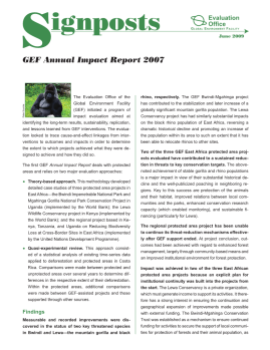The first annual impact report includes an explanation of two parallel evaluation approaches developed and tested by the Global Environment Facility's Evaluation Office (GEFEO):
- a theory-based approach to link outcomes to impact in three protected area projects in Bwindi-Mgahinga, Lewa, and at cross-border sites in Kenya, Tanzania and Uganda; and
- a statistical analysis of existing time-series data on deforestation and protected areas in Costa Rica
The AIR presents a number of conclusions, including that there are recorded improvements in the status of two key threatened species (the mountain gorilla and black rhino) in Bwindi-Mgahinga and Lewa, and that in two of the three protected area projects a sustained reduction in threats to conservation targets was seen. However, the report also reveals some negative impacts of protected area projects on indigenous Batwa which remain unresolved.
The report further concludes the most cost-effective and realistic approach to impact evaluation for the GEF Evaluation Office is a combination of opportunistic quasi-experimental analysis using available data along with targeted case studies that use a theory-based approach.
In terms of recommendations, the report suggests that protected area projects should include a specific plan for institutional continuity to be incorporated in the GEF's biodiversity tracking tools or through an alternative system developed under the direction of the GEF Secretariat. It also suggests the Evaluation Office should continue using the mixed-method approach in its future impact work.
The report was presented to the GEF Council which asked the Secretariat to:
- Incorporate the report's recommendations into future project preparation and ensure adequate monitoring of progress towards institutional continuity.
The GEF Council asked the Evaluation Office:
- Continue its program of Impact Evaluation as proposed.


